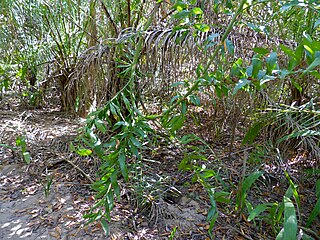
Port of Spain, officially the City of Port of Spain, is the capital of Trinidad and Tobago and the third largest municipality, after Chaguanas and San Fernando. The city has a municipal population of 37,074 (2011), an urban population of 81,142 and a transient daily population of 250,000. It is located on the Gulf of Paria, on the northwest coast of the island of Trinidad and is part of a larger conurbation stretching from Chaguaramas in the west to Arima in the east with an estimated population of 600,000.

Tobago is an island and ward within the Republic of Trinidad and Tobago. It is located 35 kilometres (22 mi) northeast of the larger island of Trinidad and about 160 kilometres (99 mi) off the northeastern coast of Venezuela. It lies to the southeast of Grenada.

Indo-Trinidadians and Tobagonians or Indian-Trinidadians and Tobagonians are people of Indian origin who are nationals of Trinidad and Tobago, whose ancestors came from India and the wider subcontinent beginning in 1845 during the period of colonization.

Araeococcus is a genus of the botanical family Bromeliaceae, subfamily Bromelioideae. It is native to northern South America, Central America and Trinidad.

Coccothrinax barbadensis is a palm found in the Lesser Antilles. Like other members of the genus Coccothrinax, C. barbadensis is a fan palm. The leaves are widely used to thatch roofs.

Bactris setulosa is a medium-sized spiny palm which is found in Colombia, Venezuela, Ecuador, Peru, Trinidad and Tobago and Suriname. It is one of the largest species of Bactris and is found at the highest elevations.
Attalea osmantha is a large pinnately leaved palm found in Trinidad and Tobago and northern Venezuela.

Desmoncus orthacanthos is a spiny, climbing palm native to tropical South America. Stems grow clustered together, and are 2–12 m long and 1.5–2 cm in diameter. Stems, leaf sheaths and often leaves are covered with black spines up to 6 cm long.

Desmoncus polyacanthos, the jacitara palm, is a spiny, climbing palm native to the southern Caribbean and tropical South America. Stems grow clustered together, and are 2–12 m long and 0.5–2 cm in diameter. Petioles, rachis, cirrus and peduncular bracts are covered with short, curved spines. Two varieties are recognised: D. polyacanthos var. polyacanthos and D. polyacanthos var. prunifer A.J.Hend.
Thoracocarpus is a genus of plants first described as a genus in 1958. It contains only one known species, Thoracocarpus bissectus a hemiepiphytic vine. It is native to Costa Rica, Panama, Cuba, Trinidad and Tobago, and South America.
The endemic flora of Trinidad and Tobago includes a total of 59 species of vascular plants belonging to 34 plant families. This is less than 3% of the total vascular plant flora of Trinidad and Tobago. Thirty-nine of these species are endemic to Trinidad, 12 are Tobagonian endemics, and six are present on both islands.
Dicliptera aripoensis is a species of plant in the family Acanthaceae which is endemic to Trinidad and Tobago. The species is only known from the Heights of Aripo, in Trinidad's Northern Range. It is a branching shrub, 1–1.5 m tall with red flowers about 3 cm long.
Justicia flaviflora is a species of herbaceous plant in the family Acanthaceae. It was previously classified as Beloperone flaviflora. The species is endemic to the island of Trinidad in the Caribbean republic of Trinidad and Tobago where it is only known from near the peaks of mountains in the Northern Range. It is an erect herb with leaves up to 27 cm (11 in) long. It is suffering from habitat degradation and has become increasingly rare, being now rated as "critically endangered".
Justicia tobagensis is a species of plant in the family Acanthaceae which is endemic to Trinidad and Tobago. The species is only known from two areas in the Main Ridge of Tobago. It was first described as Drejerella tobagensis by German botanist Ignatz Urban in his Symbolae Antillanae, based on a collection made by Danish botanist Henrik von Eggers.
Aristolochia boosii is a species of woody vine in the Aristolochiaceae plant family which is endemic to Trinidad and Tobago. Known only from a few locations in southern Trinidad, the species was first collected by Julius Boos in 1977. After determining that it was new to science, the species was described by Jacqueline Anne Panter in 1981 and named for its discoverer.

Roystonea oleracea, sometimes known as the Caribbean royal palm, palmiste, imperial palm or cabbage palm, is a species of palm which is native to the Lesser Antilles, Colombia, Venezuela, and Trinidad and Tobago. It is also reportedly naturalized in Guyana and on the islands of Mauritius and Réunion in the Indian Ocean.
Marthella is a genus of flowering plants in the Burmanniaceae, first described as a genus in 1903. It contains only one known species, Marthella trinitatis, endemic to the Island of Trinidad. It is considered critically endangered and only naturally appears in Northern Range Forest Reserve Section B. As a conservation measure, it is being cared for in the Heights of Aripo Village as a form of ex situ conservation.










